Gut commensal Parabacteroides distasonis exerts neuroprotective effects in acute ischemic stroke with hyperuricemia via regulating gut microbiota-gut-brain axis
- PMID: 39501312
- PMCID: PMC11539330
- DOI: 10.1186/s12967-024-05800-9
Gut commensal Parabacteroides distasonis exerts neuroprotective effects in acute ischemic stroke with hyperuricemia via regulating gut microbiota-gut-brain axis
Abstract
Background: Hyperuricemia is considered as an independent risk factor for acute ischemic stroke (AIS), and some AIS patients are accompanied by an increase in serum uric acid. Recent studies have highlighted the important role of gut microbiota in both hyperuricemia and AIS, but there is little available data on the relationship between gut microbiota and the pathogenesis of AIS with hyperuricemia (HAS).
Methods: Here we profiled the gut microbiota composition in 63 HAS patients and 269 non-HAS patients through 16s rRNA sequencing. Male rat with hyperuricemia were subjected to middle cerebral artery occlusion (MCAO) to establish HAS model and were then treated with Parabacteroides distasonis. Subsequently, the neurological deficit, pathological damages and blood-brain barrier disruption were evaluated. Moreover, the levels of ROS, inflammatory cytokines, NF-𝜿B pathway related protein, and vascular density markers were determined.
Results: There were significant differences of gut microbiota composition between HAS patients and non-HAS patients, and a significant decrease in the abundance of Parabacteroides in HAS patients compared to non-HAS patients. Animal experiments showed that supplementation with P. distasonis increased beneficial commensal bacteria, significantly improved neurological deficits, pathological damages and BBB disruption, as well as reduced the level of serum uric acid in HAS rats. We further demonstrated that P. distasonis treatment decreased ROS level and increased SOD2 level, thereby reducing oxidative stress. Meanwhile, P. distasonis effectively inhibited NF-𝜿B signal pathway and reduced the production of inflammatory cytokines, including TNF-α and IL-1β, alleviating the inflammatory response. Notably, P. distasonis treatment increased the levels of vascular density markers including cluster of differentiation 31 (CD31) and alpha-smooth muscle actin (α-SMA), ameliorating vascular damage in HAS rats.
Conclusions: Together, these findings highlighted the important role of P. distasonis in the pathogenesis of HAS, and its mechanism was involved in the regulation of gut microbiota-gut-brain axis, which implied a novel strategy against HAS.
Keywords: P. distasonis; Gut microbiota; Hyperuricemia associated stroke; Uric acid; Vascular damage.
© 2024. The Author(s).
Conflict of interest statement
The authors state that there are no conflicts of interest to disclose.
Figures
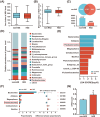
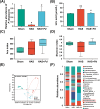
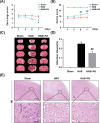
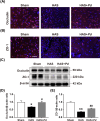

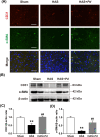

Similar articles
-
Integrative microbiomics, proteomics and lipidomics studies unraveled the preventive mechanism of Shouhui Tongbian Capsules on cerebral ischemic stroke injury.J Ethnopharmacol. 2025 Jan 30;337(Pt 2):118874. doi: 10.1016/j.jep.2024.118874. Epub 2024 Oct 1. J Ethnopharmacol. 2025. PMID: 39362332
-
Chicory ameliorates hyperuricemia via modulating gut microbiota and alleviating LPS/TLR4 axis in quail.Biomed Pharmacother. 2020 Nov;131:110719. doi: 10.1016/j.biopha.2020.110719. Epub 2020 Sep 17. Biomed Pharmacother. 2020. PMID: 33152909
-
Application of omics technology to investigate the mechanism underlying the role of San Hua Tang in regulating microglia polarization and blood-brain barrier protection following ischemic stroke.J Ethnopharmacol. 2023 Oct 5;314:116640. doi: 10.1016/j.jep.2023.116640. Epub 2023 May 16. J Ethnopharmacol. 2023. PMID: 37196812
-
Role of the gut microbiota in complications after ischemic stroke.Front Cell Infect Microbiol. 2024 Apr 5;14:1334581. doi: 10.3389/fcimb.2024.1334581. eCollection 2024. Front Cell Infect Microbiol. 2024. PMID: 38644963 Free PMC article. Review.
-
Parabacteroides distasonis: intriguing aerotolerant gut anaerobe with emerging antimicrobial resistance and pathogenic and probiotic roles in human health.Gut Microbes. 2021 Jan-Dec;13(1):1922241. doi: 10.1080/19490976.2021.1922241. Gut Microbes. 2021. PMID: 34196581 Free PMC article. Review.
Cited by
-
Parabacteroides as a promising target for disease intervention: current stage and pending issues.NPJ Biofilms Microbiomes. 2025 Jul 19;11(1):137. doi: 10.1038/s41522-025-00772-0. NPJ Biofilms Microbiomes. 2025. PMID: 40681519 Free PMC article. Review.
-
The regulation of neuroinflammatory response after stroke by intestinal flora microorganisms.Front Cell Infect Microbiol. 2025 Jun 23;15:1594834. doi: 10.3389/fcimb.2025.1594834. eCollection 2025. Front Cell Infect Microbiol. 2025. PMID: 40625834 Free PMC article. Review.
References
-
- Ma J, Xie H, Yuan C, Shen J, Chen J, Chen Q, Liu J, Tong Q, Sun J. The gut microbial signatures of patients with lacunar cerebral infarction. Nutr Neurosci. 2024;27:620–36. - PubMed
MeSH terms
Substances
Grants and funding
LinkOut - more resources
Full Text Sources
Medical

